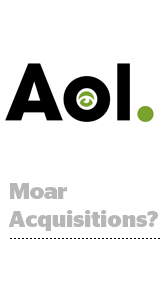 If mobile and video are the twin engines driving ad tech, then AOL’s rumored $300 million to $350 million acquisition of Millennial Media would put the pedal to the metal.
If mobile and video are the twin engines driving ad tech, then AOL’s rumored $300 million to $350 million acquisition of Millennial Media would put the pedal to the metal.
The potential deal, first reported by AOL-owned TechCrunch on Thursday, comes just a few weeks after the official close of Verizon’s $4.4 billion purchase of AOL.
With Adap.tv already under AOL’s belt on the video side, Millennial Media could prove to be AOL’s corollary for mobile – a quick way to ramp up programmatic experience and supply on the mobile side.
According to a source with knowledge of the matter, AOL has been considering Millennial for about three months – but it’s not alone in that endeavor.
Twitter was also taking a peek under Millennial’s hood, but internal leadership shuffles – Dick Costolo’s departure as CEO and the ongoing search for a new permanent chief – might have hampered the process, leaving an in for AOL.
And this isn’t the first time that possibility of an AOL/Millennial hookup has been in the air. As Richard Fetyko, SVP of Internet tech and media at ABR Investment Strategy, noted in February 2014 – roughly one month after Michael Barrett took the reins as CEO – Millennial’s platform could help plug the mobile hole in AOL’s “sizable network business.”
“As Millennial Media transitions to programmatic, its strategic value will rise,” Fetyko said. “And, with it, the chance of a take-out rises as well.”
Why Millennial?
But what does the troubled Millennial have that so many suitors want?
The answer could lie with Nexage, the mobile ad exchange Millennial bought in September for $108 million – “really good tech” that one source said Millennial “didn’t know how to market.”
But there’s more to Millennial’s stack than a mobile exchange. The company also comes complete with DMP and DSP capabilities it picked up from the acquisition of JumpTap in 2014, preceded roughly six months before that by its purchase of mobile media buying and targeting player Metaresolver.
All of that M&A arguably comprises the “end-to-end full-stack” solution Barrett has been looking to build – but all those ingredients don’t necessarily make a cake.
“They spent a lot of time and money on these acquisitions – new employees, new locations, going global – and, frankly, it was distracting,” a former Millennial employee told AdExchanger.
That said, the pieces could be attractive to a prospective acquirer. Although AOL already has SSP functionality within its programmatic tech stack, it could be gunning to take on more supply in a bid to become a bigger competitor to players like Rubicon Project, OpenX, Google’s AdX or AppNexus. (As one of Microsoft’s key ad tech partners, AppNexus has an unclear future following AOL’s recent absorption of Microsoft’s entire display ad business.)
Assuming AOL acquires Millennial, it would inherit Nexage’s exchange tech to handle more of the Microsoft supply influx internally. If Nexage combines with Verizon’s rich mobile data sets, it would be a potent combination that would make AOL/Verizon competitive with Facebook’s cross-device linkages.
That certainly seems to be part the plan, one that Verizon would also benefit from.
“Verizon has found it hard to figure out ways to capitalize on the advertising market and to decide what to do with all the data they have,” said an AdExchanger source. “Everything is driven by data right now – data, data, data is all you hear – but that means nothing if you don’t know how to use it to benefit the customer in the long run with relevant ads and all that good stuff.”
Gartner research director Martin Kihn put it this way: AOL/Verizon is developing “a mini-Facebook killer for mobile ad sales.”
“Already they’re building up a device graph that is one of the biggest in the industry in terms of mapping individuals to their various browsers and devices [and] once AOL gets Verizon’s customer data included in the graph – which they’re planning to do – it will become a (smaller) Facebook-like people-based audience targeting powerhouse,” Kihn said. “Millennial would add even more device IDs, more mobile inventory sources and more data for AOL’s attribution engine to use to measure impact. It also gives AOL more data to put into its programmatic models like the impact of location on ad effectiveness.”
To that end, it wouldn’t surprise Drawbridge CEO and founder Kamakshi Sivaramakrishnan if Verizon kept on with its acquisitive streak.
When Verizon acquired AOL in May, she said its next step would be “connecting the devices, either by using technology or in a more explicit manner. … The carriers will be very active acquirers in the near future.”
And with Verizon’s buying power behind it, AOL can afford to pay a premium for Millennial.
Though news of the possible AOL deal sent Millennial’s stock price up to $1.90 on early Thursday afternoon from $1.45 at market close the previous day, the $300 million/$350 million price AOL is reportedly willing to pay for Millennial is still higher than the company’s market cap, which rose from $217 million on Wednesday to $266 million on Thursday. (But as The Wall Street Journal pointed out, Millennial’s stock is still down more than 90% overall since its IPO in 2012.)
From Millennial’s perspective, the deal could be the exit the company appears to desperately need. Its earnings have been in the doldrums for quite some time, including in Q1 2015, when Millennial reported year-over-year losses, from $72.6 million to $63.2 million.
Although Barrett has been chasing the programmatic dream since he joined Millennial early last year – the Nexage acquisition happened under Barrett’s watch, as did the hiring of several big name execs, including AdMeld vets Marc Theermann as EVP of strategy and Jason Kelly as president of managed media – investors haven’t embraced Millennial’s attempted turnaround story.
And that’s because there are other, far bigger players on the scene, including Facebook, Google, Twitter and AOL, which have all decided to get into in-app in a big way.
“There was a time when Millennial was one of the only games in town, but it’s hard to be an independent player in a market full of consolidation and acquisition,” one source told AdExchanger. “Other companies are doing big things in-app and they have way more assets at their disposal.”
Kelly Liyakasa contributed.












